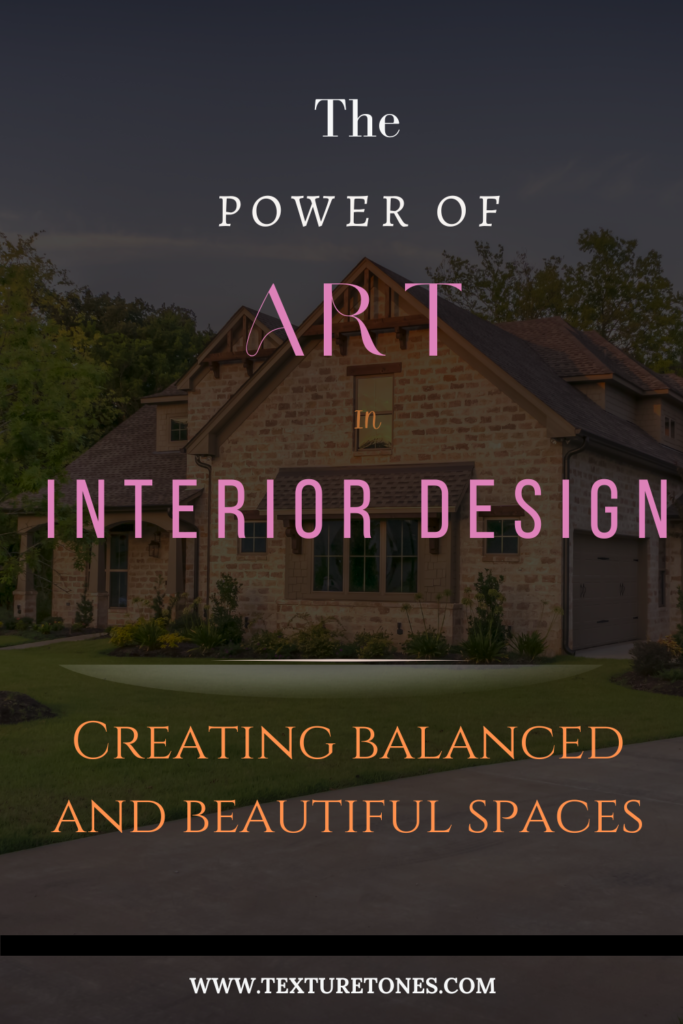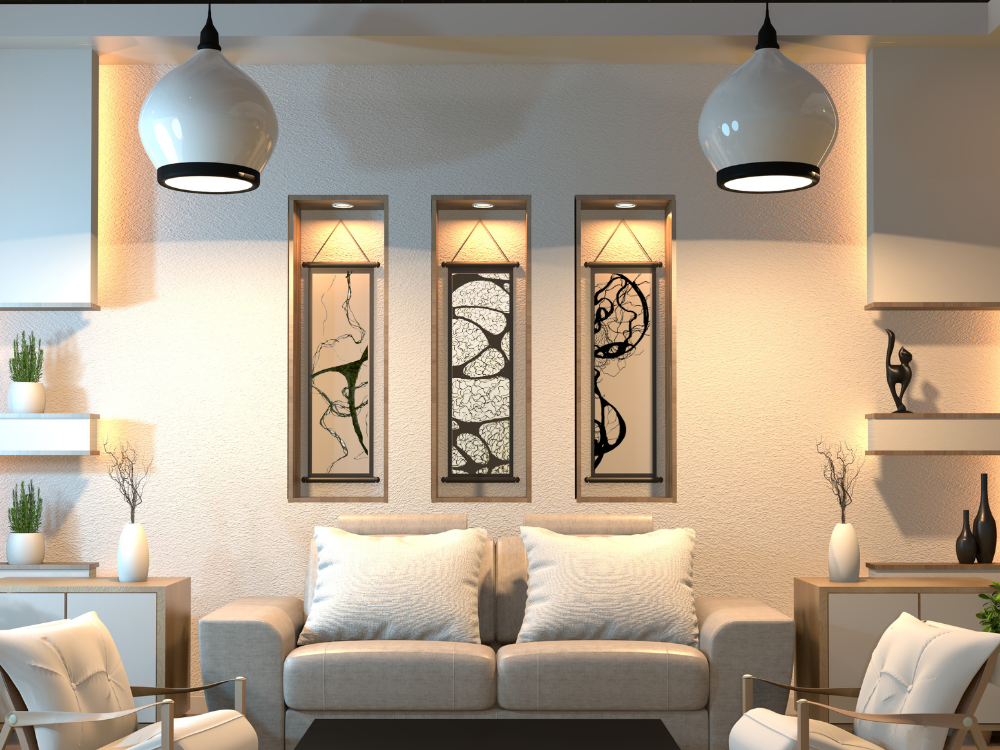
Not everyone sees art the same way, and that’s perfectly okay.
For some, it’s just something to fill an empty wall, and they don’t give it much thought. Others might think art as a reflection of their personality, a way to express their values, or even a statement piece that makes a room feel alive.
Some people spend hours choosing the perfect artwork, carefully curating their collection, and investing in pieces that truly resonate with them.
I don’t know which category you belong to, but wherever you are, I’m here to tell you that art has the power to enhance your space in ways you might not have considered before – Art is definitely ‘not’ just . a . decor.
The right piece of art can change the entire feel of a room that feels connected and alive and something that belongs to you.
And when I talk about art, I’m not saying that you need to spend thousands on original masterpieces or hang expensive paintings on your walls.
Let’s be honest—how many of us can do that?
What I’m saying is that art doesn’t have to be out of reach. It can be something simple, affordable, and still have a big impact.
In this post, I’ll share how art can become an important part of your decor and why it deserves more attention than you might think.
Are you someone who buys a painting you love, without giving much thought to its size, theme, or how it fits with the rest of your room—just to fill that empty space on your wall?
Wait… hold on a second. …
Take a moment to think about it. Does that piece of art truly belong there, or is it just filling a gap?
Let’s dig further into why the art you choose really matters before investing in any random piece.
Your home is more than just a place to live—it’s a reflection of who you are. Every decision you make, from the design and decor to the way you construct your space, says something about your personality.
There are so many things that come together to shape the feel of your home—everything from the colors and furniture to the layout, artwork, and decor. Every small detail contributes to the unique story your home.
Though all of these elements contribute, in this post, we will focus specifically on art and how it can reveal your personality and enhance your living space.
Have you ever thought about why art holds such importance in your home?
Imagine stepping into a room after a long tiring day where, even without realizing it, the art on the walls immediately shifts your mood.
The exhaustion starts to slowly fade as the piece in front of you could take you to a state of calmness, motivation or even inspiration.
Sure, the room might be clean, the bed might be comfortable, and the lighting might be perfect, but art has a unique way of transforming how you feel in a space.
You may not always notice it consciously, but the right artwork can elevate your mood in ways nothing else can.
That’s the subtle but powerful effect art can have on a space! Art isn’t just about decoration — it’s about creating an ambience that speaks to you!
Here are few ways art influences the atmosphere of your home.
Emotional connection
Yes, you read that right! Art has the incredible ability to connect with us emotionally. Whether you decide on a calming landscape for your bedroom or a bold abstract piece for your living room, the art you choose will shape the energy of the room making the space feel more relaxed, energizing, or intimate.
It’s amazing how the right artwork can completely shift the vibe and help create the mood you want to feel in that space.
Therefore, the secret lies in carefully choosing the right piece of art and knowing where it belongs.
Self-expression
Your home is a reflection of who you are, and the art you display is one of the best ways to express your personality.
Whether you prefer minimalist art, vibrant colors, or nature-inspired pieces, the artwork you select tells a story about your interests, passions, and values.
If you’re someone with a vibrant personality, you might be drawn to bold, colorful pieces like pop art that make a statement and something that reflects your lively energy.
On the other hand, if you’re more calm and introspective, you might prefer beautiful paintings of landscapes that bring a sense of peace and calmness.
For those with a creative side, abstract art could be the perfect fit.
No matter what type of personality you have, the art you choose tells a story about who you are, your interests, and the things that bring you joy.
Unifying Design Elements
Have you seen how effortlessly art can bring together different color schemes, patterns, textures and all the elements in the room by giving it a more cohesive look.
For example, let’s say you have a room full of different textures—maybe a soft velvet couch, a leather chair, and a wool rug. Those are randomly purchased because you loved each of them.
Now let’s connect it together through Art and make it look like these pieces are purchased intentionally.
Look for an art that match the tones in the colors of your furniture. Suddenly, the room feels more connected, the colors feel more intentional, and the textures all complement each other.
Art helps in creating a visual flow that makes the space feel well-thought-out and put-together, instead of looking like a mix of random elements thrown here and there.
Now if you have a room with bold patterns – patterned rug, vibrant bold patterned curtains try adding a simple monochrome piece of Art that can balance the space and prevent it from feeling too chaotic.
Art brings harmony to a room, creating a unified look that feels both stylish and organized.
How do you choosing Art That Reflects Your Style
(Please note, these examples mentioned below are only to give you an idea. You don’t need to invest heavily—prints or similar artworks can also be great alternatives that fit your space and budget)
For bold energy
If you want your space to feel lively and full of excitement, opt for art that features bright colors and bold patterns. Pieces like “Starry Night” by Vincent van Gogh or “Broadway Boogie Woogie” by Piet Mondrian are great examples. With their use of primary colors and patterns these paintings bring a lot of energy and movement into a room. Such artwork will immediately draw attention, and creates an energetic vibe to your room.
For a calming, serene vibe
If you’re looking for a peaceful, relaxing atmosphere, choose art that feels soft and natural. Nature-inspired pieces or those with gentle colors, like “Water Lilies” by Claude Monet or “The Girl with a Pearl Earring” by Johannes Vermeer”Water Lilies” are great choices. to make your room feel like a cozy, quiet retreat where you can unwind.
For warmth and elegance
If you want to create a space that feels warm and inviting, with a touch of class, go for art that has rich colors and textures. Paintings like “The Kiss” by Gustav Klimt or “Mona Lisa” by Leonardo da Vinci” are ideal because they bring warmth and sophistication to your home.
For a modern, quirky touch
If you want to add a bit of fun or something unexpected to your space, choose art that’s bold, graphic, and maybe a little playful. Works like “Campbell’s Soup Cans” by Andy Warhol or “Guernica” by Pablo Picasso are perfect for this. They bring in a modern, fresh feel, and add personality to your home with their unique and sometimes humorous touch.
For a minimalist look
If you’re aiming for a clean, modern, and uncluttered living room, minimalist black and white sketches are a perfect choice. Minimalist interiors look spacious and the simplicity and elegance of these paintings complements the decor.
Works like “Red, Blue, Green” by Ellsworth Kelly or “Orange and Yellow” by Mark Rothko are examples . Nowadays, you also see a lot of line art, simple geometric shapes, and even abstract minimal art. With so many modern options available today —from minimalist prints to digital artwork—there’s no shortage of styles to choose from that suits your needs, tastes and preference.
Finding the right balance
One of the main aspects that many of us overlook is finding the right balance with the existing furniture and furnishings you already have in the room.
Let us say you have an already furnished room with different elements, and choosing the right paintings can give it a cohesive and balanced look.
Let us say you have a living room with neutral furniture and light-colored walls, a large piece of abstract artwork with rich earthy tones can add depth and warmth to the space without overwhelming it.
Or if your space has a lot of pattern, such as a heavily patterned rug or curtains, a simple, monochromatic piece of art can provide a visual calmness that creates balance and prevents the room from looking too cluttered.
In simple words, art can balance the elements in your room by giving it a cohesive look.
So choosing the right artwork is key!
Another important factor of art is that it can reduce stress and promote feelings of happiness. Studies have shown that looking at art can reduce stress and promote feelings of calm and happiness.
Check out – Evidence for the effects of viewing visual artwork on stress outcomes.
By surrounding yourself with art that speaks to you, you can create a space that not only looks good, but also feels good, creating a positive and uplifting environment.
Easy Ways to Use Art in Your Interior Design
Let us examine how art may improve your interior design and turn your room into a work of art. Here are a few simple ways you can incorporate art into your home:
1.Start with a Statement Piece
What is a statement piece?
A statement piece is a bold, eye-catching art in a room that draws attention and sets the tone for the space. It’s typically something larger, more unique in style, such as a large painting, an amazing sculpture, or a distinctive piece of furniture. Make sure there is only one statement piece in one room and let that be on your focal point.
A large, bold piece of art can set the tone for an entire room. Whether it’s a colorful abstract painting or a striking photograph, choose a piece that speaks to you and let it be the focal point.
what a focal point is?
A focal point is the area in a room that immediately draws the viewer’s attention. It can also be referred to as the center point.
When you focus on focal point, choose art that resonates with you. Something striking!
It could be just one large piece of art.
Or
It could be an arrangement of several small paintings that follows a specific theme.
Whatever that maybe, placing the right painting on your focal point is going to make a big difference, especially if chosen in the right way that complements your furniture, wall paint and decor.
Imagine walking into a living room where a bold abstract painting immediately draws attention, like Jackson Pollock’s “No. 5, 1948”. This draws our eyes to it and sets the tone of the entire room.

If you are someone who is obsessed with minimalist interiors with clean lines and neutral tones, then you should try adding a little color to the space, to give it some depth without cluttering it. In my personal opinion, the paintings of Wassily Kandinsky would be a good choice for such a room.
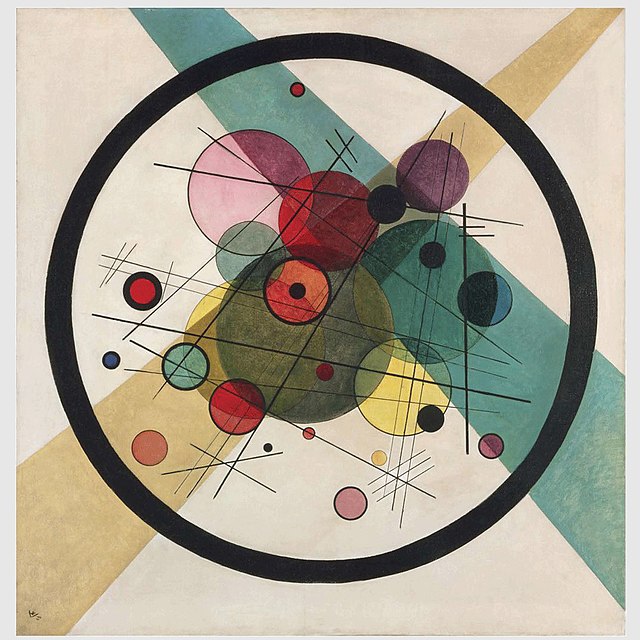
“Circles in a Circle” by Wassily Kandinsky(1923)- Wikimedia Commons
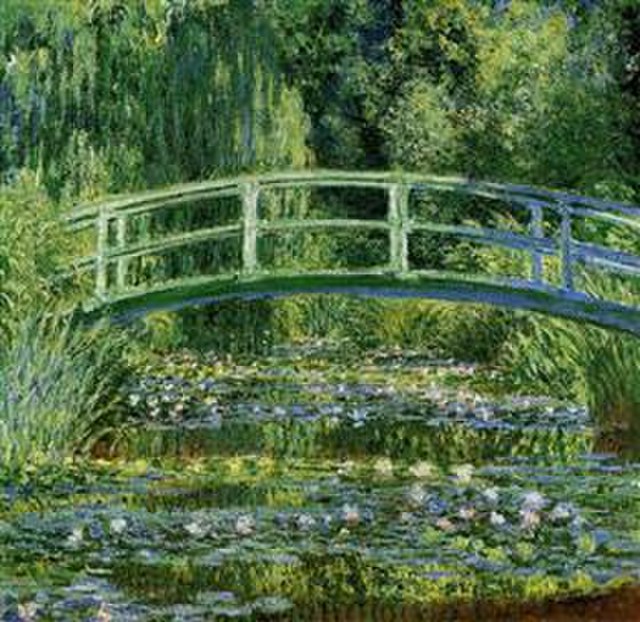
“Japanese Bridge Waterlily Pond” by Claude Monet(1899)-Wikimedia Commons
In a more rustic or bohemian setting, on the other hand, a nature-inspired work such as a landscape by Claude Monet can go well with the natural, tranquil mood.
Another theme would be how a soft, textured painting with subtle metallic tones could add warmth and sophistication to a minimalist dining room, reflecting light in a way that enhances the room’s simple, elegant aesthetic.
Whether you’re redesigning an entire room or doing a makeover of an existing room, It’s not just about choosing a piece of art that you like — it’s about choosing art that harmonizes with the overall theme and energy of your home.
2. Create a gallery wall
Gallery walls are a fun and easy way to display multiple artworks while keeping the space cohesive. You can mix different sizes, frames, and styles—just make sure there’s a common theme, color palette, or subject matter to tie everything together.
This could be a collection of black-and-white photography, a mix of nature-inspired prints, or abstract pieces that flow together.
A gallery wall is a fantastic way to display multiple pieces of art in a cohesive way.
Plan your layout
Before hanging or placing your artwork, plan your layout.
Use painter’s tape to sketch the size and placement of the artwork on the wall, or lay the pieces out on the floor to visualize their arrangement.
For gallery walls, it is advisable to arrange the pieces on the floor first to experiment with different configurations.

This way you can ensure a balanced and aesthetically pleasing arrangement before drilling holes in the wall or making permanent fixings.
Here’s the link below for your free Canva template to explore different gallery wall styles.
It’s fully editable, so you can easily add your artworks and see how everything will come together before making any final decisions.
Gallery Wall Templates: Plan and visualize your gallery wall arrangements.
(In this post I have included 15 Free Canva templates you can download to add your artworks and see how it looks on the wall by playing around with different styles)
3. Use Art to Complement Your Color Scheme
One of the simplest ways to use art in your interior design is to match it with your existing color theme. If your room has soft neutral tones, choose a piece of art that brings in a pop of color, such as a vibrant landscape or a modern abstract painting with bold colors .
If your space already has lots of color, consider opting for a more subdued piece with neutral tones to balance things out.
Art doesn’t have to clash with your room’s palette—it can work seamlessly with it to enhance the overall vibe.
4. Consider scale and placement
When placing works of art, consider the scale of the work in relation to the space.
Large, expressive works fit well above sofas or beds, while smaller works can be grouped in smaller areas such as hallways or above a console table.
Have you seen the large, dramatic work such as Gustav Klimt’s “The Kiss”?
It is a perfect example to take center stage above a mantelpiece or in a spacious living room.

Conversely, a series of smaller botanical prints can beautifully decorate a hallway or breakfast nook, adding a touch of nature to everyday life.
5. Balance Art with your furnishings
Art should complement your existing décor, not compete with it.
If you have a lot of patterned furniture or bright colors, opt for more subtle artwork that will enhance your decor rather than overpower it.
On the other hand, if your room is more neutral – bold and colorful artwork can be the perfect choice.
For example, in a minimalist room with neutral tones , you could either opt for subtle minimalist art with clean line art or simple abstract art.
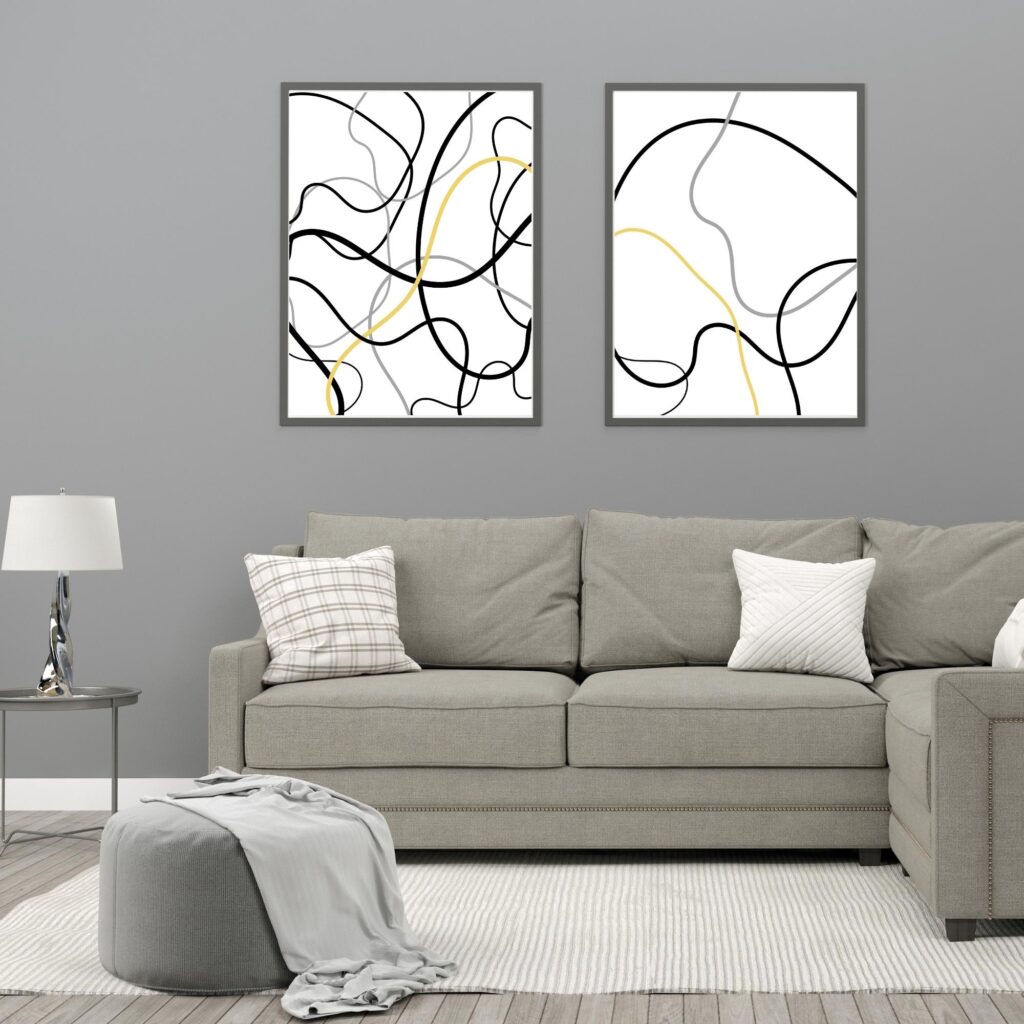
or in my personal opinion I would prefer to add a bit of color in order to balance the neutral tone of the room.
On the other hand while a room with eclectic patterns might do better with muted, monochromatic art.
6.Incorporate art into functional spaces
Don’t limit art to the walls — think about incorporating it into other areas of your home.
Art can be used on functional items such as custom printed textiles, decorative trays or even as part of your furniture design.
Imagine, for example, a set of cushions adorned with your favorite abstract motifs, adding both comfort and style to your living area.

7. Opt for Subtle and Minimal Art for Small Spaces
If you have a small room choose art that adds depth and lightness to the space.
Minimalist Art can make a small space feel larger and more open. A subtle landscape, a delicate line drawing, or a simple graphic print can make a big impact without overwhelming the space.
Art doesn’t need to be always large to make a statement—it’s all about finding the right balance for the room.
The size and layout of the room play a big role in selecting the perfect artwork.
A large painting might work wonders as a striking focal point in a spacious living room, but in a smaller room, it could easily overwhelm the space. The key is to balance the art with the size of the room and finding a size that complements the space.

Here’s is a related post on How to hang art on your wall- 7 simple steps where I have explained how to hang art using the 7 simple steps.
Conclusion
By carefully selecting and arranging art, you can create a space that feels like you and emphasizes your lifestyle.
Remember, planning might take a bit of your time, but it’s so worth it. It’s better to take a moment now rather than rush into things, only to realize later that it didn’t turn out the way you hoped for and by then , you’ve already ruined the walls.
It might feel overwhelming at first, but careful planning now will save you a lot of stress later on. Trust me!
So finally, when you carefully select a piece of art, you’re not just choosing something to look at—you’re creating an experience, a feeling that transforms your home into a reflection of your emotions.
